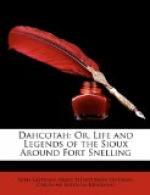The language of the Sioux would, with proper facilities, be easily acquired. It is said, in many respects, to resemble the ancient Greek. Even after having acquired considerable knowledge of the language by study, it is necessary to live among the people in order to understand their fanciful mode of speaking.
One of the chiefs, “Sleepy Eyes,” visited a missionary not many weeks since, and on being asked why he did not come at the time appointed, replied, “How could I come when I have no mocassins,” meaning that he had no horse. The horse had recently been killed by a man who owed him a grudge; and his way of alluding to the loss was the mocassins. On another occasion, this same chief, having done what he considered a favor for the missionaries, at Traverse des Sioux, told them that his coat was worn out, and that he had neither cloth nor thread to mend it; the fact was, that he had no coat at all, no cloth nor thread; his brawny neck and arms were entirely bare, and this was his way of begging for a new coat.
In Indian warfare, the victor takes the scalp of his enemy. If he have time, he takes the entire scalp, including the ears; but if hurried, a smaller scalp-piece is taken. As an inducement to be foremost in battle, the first four that touch the dead body of an enemy, share the honors that are paid to the one who slew the foe and took the scalp. But the victors in Indian fight frequently suffer in this way; a wounded savage feigns death, and, as some warrior approaches to take his scalp, he will suddenly rise, discharge his gun, and fight desperately with the tomahawk until killed. Deeds of valor performed by Indians are as often done from desperation as from any natural bravery. They are educated to warfare, but often show great disinclination to fight; strategy goes farther with them than manly courage does. At Fort Snelling, the Sioux have more than once crouched under the walls of the fort for protection, and on one occasion a chief, who came in to give information of the approach of some Chippeways trembled so as to shake the ornaments about his dress.
INDIAN WRITING.
[Illustration: No. I and 3, prisoners captured by No. 2. (No hands on the prisoners.) No. 1, female prisoner. No. 3, male.]




